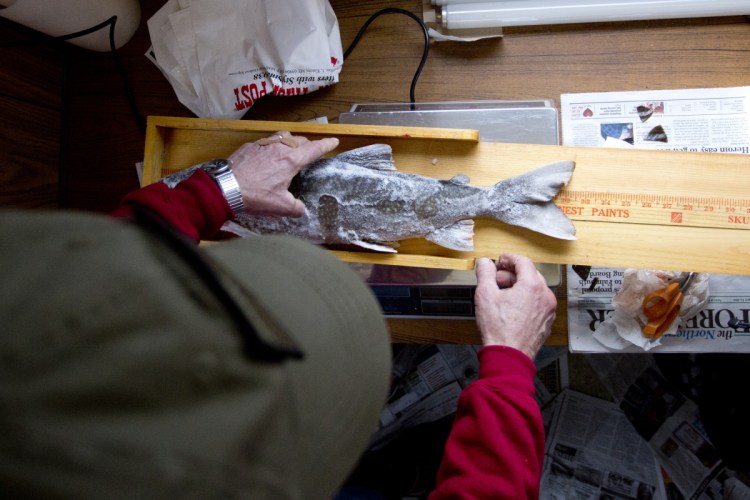A new regulation for lake trout will allow competitors in the Sebago Lake Rotary Ice Fishing Derby to enter larger fish, and, in turn, potentially help the lake’s struggling salmon fishery.
This year lake trout, also known as togue, in the 23- to 25-inch range can be kept and entered in the contest, while those 26 to 33 inches long must be thrown back. Previously, the so-called slot limit for togue was 23 to 33 inches and any fish in that range had to be released.
“That will help the tournament. Many people can now catch and keep a 25-inch fish that could be the winning fish,” said Bryan LaBreck of Standish, a lifelong Sebago fisherman.
Having more togue that qualify for entry into the derby this weekend should mean that more of the trout will come out of the lake, a boon to the salmon that are in the lake and competing for food.
“The problem is, in general (outside the derby), people are not keeping the togue they catch. You can tell because there are too many small togue, and there are too many fish in the lake,” LaBreck said.
The derby, organized by the Sebago Lake Rotary Club in partnership with the Maine Department of Inland Fisheries and Wildlife, is an annual fundraiser for local charities, but it was started 18 years ago as a way to thin the lake’s prolific togue population to help Sebago’s prized game fish: the landlocked salmon.
Held at Sebago Lake and area ponds and lakes in Cumberland County on Saturday and Sunday, it’s Maine’s biggest ice fishing derby, drawing as many as 5,000 fishermen, though the number of entrants has fluctuated. Last year, the derby had 1,052 entrants and registered around 4,000 fish, said the rotary club’s Cyndy Bell, a derby organizer.
Every year, the removal of togue from the lake is a focus. This year, a total of $10,000 in prizes will be awarded to encourage fishermen to enter lots of togue – and for the ninth year, a $100,000 insurance prize will be awarded to anyone who catches a state-record togue. The record 31.8-pound lake trout was caught by Hollis Grindle of Ellsworth in 1958 on Beech Hill Pond in Otis.
The rotary will collect fish entered in the prize pool to give to food kitchens with the help of Nova Seafoods in Portland, which will process the fish for free. Last year, the derby donated 275 pounds of processed fish to Preble Street’s kitchen, the rotary’s Clare Woodman said.
But catching a big fish is the goal of most fishermen in the Sebago derby.
“My wife last year caught a 32.5-inch togue, but had to throw it back because of the slot limit,” LaBreck said. “I’ve done the derby every year it’s been held. I know a lot of people who have done it every year. They look forward to it every year.”
The previous size limit on Sebago was introduced in 2012 to help grow the trophy togue in Sebago, but the result was “way too many togue in the lake,” said IF&W regional fisheries biologist Jim Pellerin in Gray.
Having too many togue in Sebago means the supply of forage fish, such as smelts, is depleted, which hurts the salmon fishery.
Pellerin said because so many fishermen today practice catch-and-release and release fish that are legal to keep, the state is trying to find ways to encourage the removal of more togue from the lake to help a flagging salmon fishery.
“It’s a problem. It’s impacting the salmon and the quality of the lake trout’s size,” Pellerin said. “The salmon fishery is not doing well. About 80 percent of the spawning salmon in the Crooked River area are wild. But the salmon, I would say, are in poor condition.”
Pellerin hopes the more liberal size limit on togue results in as many as 5,000 togue being removed from Sebago this winter.
A flight survey done from a float plane will help biologists measure the success of the slot limit.
“We’re seeing a 60 percent release rate on fish (that are legal),” Pellerin said. “With a release rate that high, it makes the regulations ineffective. People need to harvest fish.”
Deirdre Fleming can be contacted at 791-6452 or at:
dfleming@pressherald.com
Twitter: FlemingPph
Send questions/comments to the editors.



